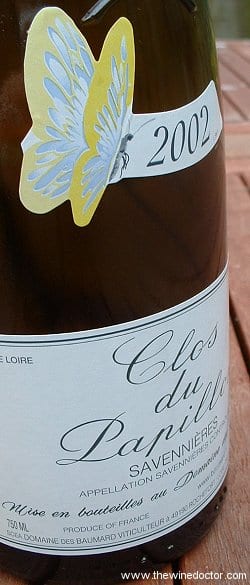Domaine des Baumard Savennières Clos du Papillon 2002
After last week’s minor exploration of Sancerre, which is perhaps the Loire’s best known appellation for white wine, this week one that is more of a rising star, Savennières. And I’m looking in particular at one of its best known wines from Jean and more recently Florent Baumard, who are based across the river from the appellation in Rochefort-sur-Loire. Although Domaine des Baumard has released, for many years, several cuvées of Savennières including the Trie Speciale and one from the lieu-dit Clos de Saint Yves, it is the one from the Clos du Papillon that usually stirs most interest amongst fans of this domaine.
Although a rising star Savennières is by no means a new appellation, having first been formally defined by the INAO in 1952. It is more how the style of wine has developed over the last few decades that has brought it to our attention; initially predominantly demi-sec or doux, the wines perhaps struggled with a unique identity, I imagine being somewhat overshadowed by more successfully sweet appellations such as the Coteaux du Layon, Quarts de Chaume and Bonnezeaux. It is in more recent years, with a new tendency to vinify the wines dry, a style that now accounts for the vast majority of the appellation’s output, that the wines have really made their mark. Despite this, some still seem to find it difficult to really get to grips with Savennières. Only a couple of weeks ago Jonathon Ray, writing in The Telegraph, declared that Savennières was, along with Menetou-Salon, Quincy and others, a fine source for high quality examples of Loire Sauvignon Blanc. Oops! Thankfully the INAO haven’t seen fit to follow Ray’s subconscious desire to permit this variety, noble as it is, for Savennières; this is a 100% Chenin Blanc appellation, and it is in my opinion the supreme source of this variety vinified dry.

Despite this burgeoning reputation Savennières is not a huge appellation. The INAO regulations, which at the time of writing were last updated in 2005, describe only 146 hectares of vineyards scattered across just three communes, these being Bouchemaine, La Possonnière and Savennières itself. And that includes the two crus of Roche-aux-Moines and Coulée de Serrant – according to Virginie Joly the latter alone accounts for 7 hectares, but the former is a whopping 33 hectares all told, leaving a little over 100 hectares of straight Savennières. To compound this, in recent years it has been shrinking; take a drive around the back roads of the appellation, occasionally with a little exploration on foot, and you will spot untended and overgrown vines, and the walls of almost forgotten vineyards covered in wild vegetation. Fortunately I suspect renewed interest in these wines, and suitable financial returns – Savennières fetches a premium over generic Anjou – will stem this haemorrhage of vineyard. It may even bring new blood into the commune, and some of the abandoned vineyards will be cleared and brought back to life. It will be fascinating to see, or rather taste, the results of such labours.
And so to this wine. The Baumard’s interpretation of Savennières can certainly be distinctive, and it might be worth taking a moment to consider this before tasting. The Baumard family own 7 hectares of this lieu-dit, so about half of the vines, although unusually there are a few rows of Chardonnay planted here alongside the Chenin Blanc. Although today this goes into the Crémant de Loire, in years gone by – long before this 2002 was made, I am sure – it was not unknown for it to be suggested that some of this fruit might just have been mixed with the Chenin for the Clos du Papillon Savennières, although naturally such an act, which would not be in adherence with the appellation regulations, has always been denied. Of note the vines for Baumard’s Verdelho, which surprises many when they encounter it for the first time, this not being a grape associated with the Loire, are situated in their other lieu-dit Clos de Saint Yves, and there were from time to time similar allegations regarding that variety’s ultimate fate. Anyway, back to this wine. The Clos du Papillon is fermented in stainless steel, and then held in cuve until ready for bottling, so there is absolutely no contact with oak at all in current vintages (although they have experimented with this in the past). Malolactic fermentation, which is one factor in a wine being labelled as ‘modern’ or ‘traditional’ within the Savennières sphere, is not consistently undertaken, so it isn’t easy to pigeonhole Baumard; in fact, I think they probably need their own pigeonhole, separate from their peers. The Domaine des Baumard Savennières Clos du Papillon 2002 has a rather pale hue in the glass, lemon-gold in colour, although I suppose my perception may be influenced by my expectations of richness and power. The nose isn’t giving much away at first, showing a faint minerality, with more that a hint of wet ash. With time in the decanter it opens out, to reveal honey-tinged (although not sweet) minerals and straw. The palate shows nice weight on entry, good substance with a dry character, and plenty of bitter grip underneath it all. There is a good vein of minerality at the core, and a nice, rounded substance. The flavour profile is certainly distinctive, showing nettles, ash, chalky rock dust and more. A firmly composed wine, which in fact seems a touch hard on the palate at the moment, and I suspect it is going through something of an awkward phase right now. Nevertheless there is fine potential here I think. Leave well alone for a year or two I think. 17.5+/20 (16/2/09)
Find Dom. des Baumard Savennières Clos du Papillon 2002 on Wine Searcher: ![]()
